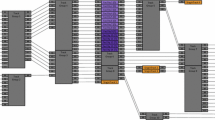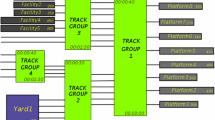Abstract
In this article we present our contribution to the Rolling Stock Unit Management problem proposed for the ROADEF/EURO Challenge 2014. We propose a greedy algorithm to assign trains to departures. Our approach relies on a routing procedure using multi-interval constraint propagation to compute the individual schedules of trains within the railway station. This algorithm allows to build an initial solution, satisfying a significant subset of departures.







Similar content being viewed by others
References
Benhamou, F., & Granvilliers, L. (2006). Continuous and interval constraints. Foundations of Artificial Intelligence, 2, 571–603.
Chabert, G., & Jaulin, L. (2009). Contractor programming. Artificial Intelligence, 173(11), 1079–1100.
Floyd, R. W. (1962). Algorithm 97: Shortest path. Communications of the ACM, 5(6), 345.
Hudak, P., Hughes, J., Peyton Jones, S. & Wadler, P. (2007). A history of haskell: Being lazy with class. In Proceedings of the Third ACM SIGPLAN Conference on History of Programming Languages (pp. 12-1–12-55). ACM.
ILOG, S. (1999). Revising hull and box consistency. In Logic Programming: Proceedings of the 1999 International Conference on Logic Programming, (p. 230). MIT Press.
Johnsson, T. (1984). Efficient compilation of lazy evaluation. SIGPLAN Notices, 19(6), 58–69.
Knüppel, O. (1994). Profil/biasa fast interval library. Computing, 53(3–4), 277–287.
Lerch, M., Tischler, G., Gudenberg, J. W. V., Hofschuster, W., & Krämer, W. (2006). Filib++, a fast interval library supporting containment computations. ACM Transactions on Mathematical Software (TOMS), 32(2), 299–324.
Madsen, A. L., & Jensen, F. V. (1999). Lazy propagation: A junction tree inference algorithm based on lazy evaluation. Artificial Intelligence, 113(1), 203–245.
Moore, R. E. (1966). Interval analysis., Prentice-Hall series in automatic computation Englewood Cliffs: Prentice-Hall.
Ninin, J. (2015). Global optimization based on contractor programming: An overview of the ibex library. In International Conference on Mathematical Aspects of Computer and Information Sciences (pp. 555–559). Springer.
Ramond, F., & Marcos, N. (2014). Trains don’t vanish ! ROADEF EURO 2014 challenge problem description. Technical report, SNCF—Innovation & Research Department. https://hal.archives-ouvertes.fr/hal-01057324.
Rogers, D. F., Plante, R. D., Wong, R. T., & Evans, J. R. (1991). Aggregation and disaggregation techniques and methodology in optimization. Operations Research, 39(4), 553–582.
Author information
Authors and Affiliations
Corresponding author
Rights and permissions
About this article
Cite this article
Joudrier, H., Thiard, F. A greedy approach for a rolling stock management problem using multi-interval constraint propagation. Ann Oper Res 271, 1165–1183 (2018). https://doi.org/10.1007/s10479-017-2543-y
Published:
Issue Date:
DOI: https://doi.org/10.1007/s10479-017-2543-y




